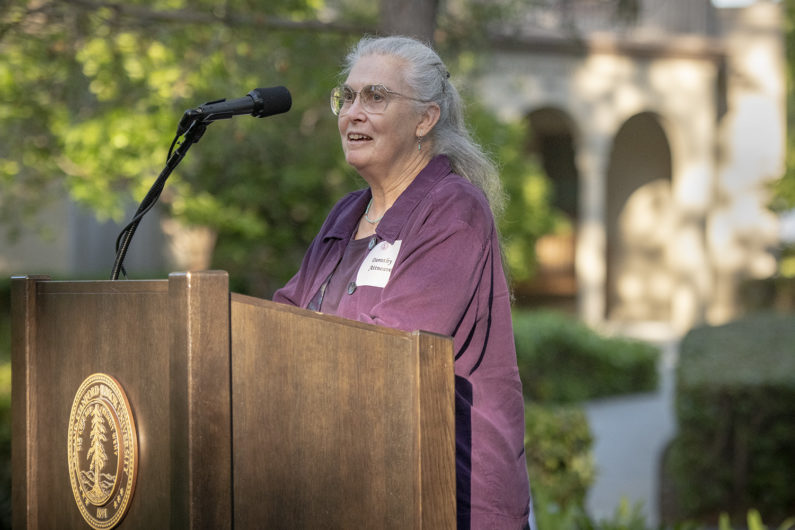Clayman Institute building renamed for Stanford alumna Carolyn Attneave
The building housing Stanford’s Clayman Institute for Gender Research has been renamed to honor Stanford alumna and psychologist Carolyn Lewis Attneave, who is credited with establishing the field of Native American mental health.

Dorothy Attneave, daughter of Carolyn Attneave, speaking at the dedication of the building in honor of her mother. (Image credit: L.A. Cicero)
When staff and faculty at the Clayman Institute for Gender Research learned that their building would be renamed for Stanford alumna and psychologist Carolyn Lewis Attneave, they were both excited and inspired, according to institute director Shelley Correll.
Correll, the Michelle Mercer and Bruce Golden Family Professor of Women’s Leadership, told a crowd gathered Tuesday for the official renaming of the building, that the parallels between Attneave’s work and that of the Clayman Institute quickly became clear to the staff, making the renaming fitting.
“Since 1974, the Clayman Institute has conducted forward-thinking gender research and put research into action to create a more equitable society,” Correll said, adding, “We are motivated to shed light on gender and intersectional inequalities and to draw attention to and collaborate with those who have been historically marginalized in our institutions and organizations.”
Much the same can be said of Attneave, a psychologist who established the field of Native American mental health when she began her professional career in the 1950s. She died in 1992. The American Psychological Association created an award in Attneave’s honor that recognizes the promotion of diversity in family psychology or special contributions to the lives of diverse families.
Second renaming
The building renaming ceremony was the second such event held on campus in the last several weeks. On April 19, members of the campus community gathered in the Stern Hall complex to celebrate the naming of an undergraduate residence in honor of alumna and astronaut Sally Ride. Both the Clayman Institute building and the residence hall had been named Serra House for Junipero Serra, a Catholic missionary whose practices in converting Native Americans in the 1700s have come under scrutiny in recent years.
The renamings follow a decision in 2018 by the Board of Trustees to accept a recommendation that originated with two campus groups to rename some campus features previously named for Serra. The renaming process began in 2016, when the Undergraduate Senate and Graduate Student Council of the Associated Students of Stanford University, citing concerns raised by Native American students, asked the university to rename facilities bearing Serra’s name.

Provost Persis Drell, Dorothy and Philip Attneave, children of Carolyn Lewis Attneave, and President Marc Tessier-Lavigne pose in front of the newly renamed Carolyn Lewis Attneave House. (Image credit: L.A. Cicero)
As he did at the Ride renaming ceremony, President Marc Tessier-Lavigne acknowledged that Tuesday’s gathering occurred on the ancestral land of the Muwekma Ohlone Tribe. Members of the Ohlone Tribe were on hand to speak to that significance and to share food that harked to Ohlone culture.
“This renaming affirms Stanford’s values and in particular the importance we place on inclusion,” Tessier-Lavigne said.
As part of the ceremony, members of the Stanford American Indian Organization also presented the Clayman Institute with a framed blanket meant to honor and commemorate Attneave’s legacy and the contributions of Native Americans to Stanford.
Attneave’s legacy
Attneave was born of mixed Lenni-Lanape and Scandinavian heritage and dedicated her professional life to cross-cultural understanding. At Stanford, she earned her master’s degree in 1947 and her doctorate in 1952, both in education.
Attneave helped found organizations now known as the Society of Indian Psychologists and the North American Indian Center of Boston. She taught at the Boston University School of Medicine and the University of Washington, worked with the Harvard School of Public Health and conducted research at Sant Vincent College in Latrobe, Pennsylvania.
Professor of Education Teresa LaFromboise knew Attneave and recommended her to the committee appointed by Debra Satz, dean of the School of Humanities and Sciences, to consider names for the Clayman Institute building.
LaFromboise first learned of Attneave’s work while studying at the University of Oklahoma. At the time, Attneave was the sole mental health worker in an area of Oklahoma encompassing seven Native American tribal nations. She was widely respected, LaFromboise said, for her inclusiveness and her respectful collaboration in providing services to those in need.
LaFromboise later had the opportunity to interview Attneave about being one of the first Native American psychologists, about her wide-ranging career and about her pioneering work in expanding family therapy to include social networks.
Also speaking were Attneave’s children, Philip and Dorothy Attneave, who suggested that their mother would be “amazed, amused and deeply honored” to have the Clayman Institute building bear her name. But they noted the appropriateness, as well.
“She worked outside expected norms for women throughout her entire career,” her son said.
